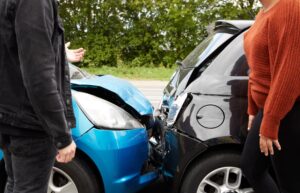In a nutshell, a no-fault claim means you typically turn to your own car insurance for injury-related expenses after an accident, regardless of who messed up and caused the collision. However, for Show-Me State residents, Missouri plays by a completely different set of rules.
If you’re tangled up in the aftermath of a car accident and need to make sense of your rights here in Missouri, give the team at Cook, Barkett, Ponder & Wolz a call at (573) 335-6651. Our car accident attorneys help clear the fog and lay out your options in plain English.
Breaking Down No-Fault
While every state operates slightly differently, the general idea is that in states with no-fault insurance laws, if you are involved in a car accident, your own automobile insurance policy steps up to cover your medical expenses and certain other losses. This happens up to a specified limit, and it applies regardless of who was actually to blame for the accident. So, even if the other driver was clearly at fault, you first look to your own insurer. This system means your insurer pays for your injuries and those of your passengers, at least initially.
The intended purpose behind this approach is twofold. First, it aims to provide quicker payment for injury-related expenses. Instead of waiting for a lengthy fault determination process, injured individuals have a more immediate source of funds for medical care. Second, the idea is to reduce the number of lawsuits clogging up the courts, especially for smaller injury claims. The logic is that if everyone’s own insurance handles their minor injuries, there will be fewer reasons to sue each other.
Personal Injury Protection (PIP): Your Go-To in a No-Fault System
The mechanism that makes no-fault work is a type of coverage usually called Personal Injury Protection, or PIP. If you live in a no-fault state, PIP is a mandatory part of your auto insurance policy. Think of it as your first line of defense for your body if a crash occurs.
So, what does this PIP coverage typically pay for? PIP coverage typically assists with a range of costs stemming from your injuries, going beyond minor expenses. Generally, PIP helps with a range of costs stemming from your injuries:
- Medical treatment: This includes expenses like doctor visits, hospital stays (emergency room and beyond), prescription medications, surgical procedures, and rehabilitative therapies such as physical therapy.
- Lost wages: If your injuries prevent you from working, PIP is designed to compensate you for a portion of the income you’re losing during your recovery period.
- Essential services: This covers replacement services for tasks you typically perform but cannot due to your injuries. For example, if you need childcare because you’re incapacitated, or require help with household chores like cleaning or grocery shopping.
- Funeral expenses: In the tragic event that injuries from a car accident result in death, PIP coverage may also extend to cover funeral and burial costs.
PIP is not a blank check. Policies always have maximum payout amounts, known as PIP limits. These limits vary by state, and some states might have different required minimums or even allow drivers choices in their coverage levels. For example, Michigan famously overhauled its no-fault system in 2020, giving drivers options for their PIP coverage amounts where previously it was unlimited. Your particular policy’s PIP limit dictates the maximum your insurer will pay out under this coverage for any single accident.
Key Distinction: No-Fault Usually Applies to Injuries, Not Vehicle Damage
A very important point that often causes confusion is that no-fault systems primarily deal with bodily injuries. What about your smashed-up car? How do you get your vehicle repaired or replaced?
In most no-fault states, the rules for property damage – that is, damage to your car or other property – are still typically handled based on who was at fault for the accident. This means you would usually make a claim against the at-fault driver’s property damage liability insurance. Alternatively, if you carry collision coverage on your own policy, you might use that, and your insurer might then seek reimbursement from the at-fault driver’s company (a process called subrogation).
So, while your PIP covers your medical bills, you’ll likely still be dealing with the other driver’s insurer, or your own collision coverage, when it comes to fixing your fender bender or more serious vehicle damage. This dual system (no-fault for injuries, fault-based for property) exists in many no-fault jurisdictions.
The No-Fault Map: Which States Use This System?
There isn’t a massive list of states that operate under a “pure” no-fault system, but they represent a significant chunk of the driving population. Currently, about a dozen states are generally considered no-fault states. These typically include places like Florida, Hawaii, Kansas, Massachusetts, Michigan, Minnesota, New York, North Dakota, and Utah. Puerto Rico also operates under a no-fault system.
“Choice” or “Optional” No-Fault States
To add another layer to the mix, a few states have what’s known as a “choice” or “optional” no-fault system. In these states, drivers are given a choice when they purchase their auto insurance policy. They might be able to opt for a no-fault policy (with PIP benefits and limitations on lawsuits) or a traditional tort liability policy (where fault determines everything).
States like Kentucky, New Jersey, and Pennsylvania are prominent examples of these “choice” systems. In Kentucky, for instance, drivers are presumed to have no-fault coverage unless they formally reject it in writing. In New Jersey, drivers choose between a “basic” policy with limited PIP and no right to sue for pain and suffering, or a “standard” policy where they can select a “limited right to sue” (cheaper, similar to no-fault verbal threshold) or an “unlimited right to sue” (more expensive, traditional tort).
Why would someone choose one over the other if given the option? Generally, opting into a no-fault system or a policy with more restrictions on suing might mean lower insurance premiums. On the flip side, preserving your full right to sue through a traditional tort policy gives you more avenues for recovery if someone else injures you, but it often comes with a higher price tag for coverage. It’s a trade-off between cost and the scope of your legal options.
When Can You Sue in a No-Fault State?
We’ve established that in no-fault states, your own PIP covers your initial medical bills. But what if your injuries are really bad? What if the PIP limits aren’t enough, or what about compensation for things like pain and suffering, which PIP typically doesn’t cover?
The “Threshold” Concept: Getting Past No-Fault Limitations
No-fault systems aren’t designed to let seriously negligent drivers completely off the hook for severe harm they cause. Most no-fault laws include what are known as “thresholds.” If your injuries or expenses meet or exceed these thresholds, you then regain the right to step outside the no-fault system and pursue a traditional tort claim (a lawsuit) against the at-fault driver.
This lawsuit would be for non-economic damages like pain, suffering, emotional distress, and loss of enjoyment of life, as well as for economic damages that exceed your PIP coverage. The idea is to reserve lawsuits for more serious injury cases.
Types of Thresholds
These thresholds vary from state to state but generally fall into two categories:
- Verbal Threshold (Serious Injury): This type of threshold requires that your injury meets a specific descriptive definition outlined in that state’s law. The definitions usually point to severe outcomes. Examples include:
-
- Significant and permanent loss of an important bodily function.
- Permanent injury within a reasonable degree of medical probability, other than scarring or disfigurement.
- Significant and permanent scarring or disfigurement.
- Death.
Essentially, the injury must be qualitatively “serious” as defined by statute. Simply having some pain or temporary discomfort won’t meet this bar.
- Monetary Threshold: This type of threshold is based on the amount of your medical expenses. To sue for pain and suffering, your necessary medical treatment costs resulting from the accident must exceed a certain dollar amount set by that state’s law. For instance, a state might set a monetary threshold at $2,000, $5,000, or even higher. If your medical bills are below this amount, you typically cannot sue the at-fault driver for pain and suffering, even if they clearly caused the crash.
Some states might use one type of threshold, while others might use a combination or offer choices within their “choice” no-fault systems. It’s a detail that is highly specific to each no-fault state’s particular legislation.
Missouri’s Approach: The “At-Fault” (Tort Liability) System
Turning to Missouri, it is important for Missourians to understand how our state handles car accident claims.
Missouri does NOT use a no-fault system for car accidents. The state operates under what’s known as an “at-fault” system, also sometimes called a “tort liability” system. This is the traditional way of handling things.
What does this mean in practical terms? It means that in Missouri, the person who is legally determined to be at fault for causing the accident is responsible for the damages they cause. This responsibility extends to bodily injuries, property damage (like wrecking your car), lost wages, and other related losses suffered by the victims of their actions.
So, if another driver runs a red light and T-bones you in an intersection in Cape Girardeau, their negligence makes them liable. If you are injured as a result, you will typically seek compensation from the at-fault driver’s liability insurance policy. If they are uninsured, underinsured, or if their insurance company isn’t offering a fair settlement, your recourse may involve filing a personal injury lawsuit directly against the at-fault driver.
Missouri’s Mandatory Insurance Laws (Financial Responsibility)
Because at-fault drivers are responsible for the damage they cause, Missouri law requires drivers to demonstrate financial responsibility. The most common way to do this is by carrying liability insurance. This ensures that if you cause an accident, there’s a source of funds to compensate those you’ve harmed.
Missouri has specific minimum coverage amounts that all drivers must carry. As per Missouri Revised Statutes §303.190, these minimums are often referred to by a series of numbers: 25/50/25. These minimums, often referred to by a series of numbers (25/50/25), signify the following:
- $25,000 for bodily injury per person: This is the maximum amount the at-fault driver’s insurance will pay for injuries to any one person in an accident they cause.
- $50,000 total for bodily injury per accident: This is the maximum total amount the insurer will pay for all injuries combined in a single accident, regardless of how many people are injured.
- $25,000 for property damage: This is the maximum amount the insurer will pay for damage to the other person’s vehicle or other property.
While these are the minimums, it is frequently advisable to carry higher levels of coverage. If you cause an accident and the damages exceed these amounts, you could be held personally liable for the difference. Similarly, if you are hit by someone with only minimum coverage and your damages are severe, their insurance may not be enough to cover all your losses. This is where your own Uninsured/Underinsured Motorist coverage becomes important.
Understanding “Pure Comparative Fault” in Missouri
Life isn’t always black and white, and neither is fault in an accident. Sometimes, more than one driver shares responsibility for a collision. Missouri addresses this through a legal doctrine called “pure comparative fault.”
Pure comparative fault operates as follows: Under pure comparative fault, you are still able to recover damages even if you were partially at fault for the accident. However, the amount of compensation you receive will be reduced by your percentage of fault. For example, imagine you are in an accident and incur $100,000 in damages. If it’s determined that you were 20% at fault for the accident (perhaps you were slightly speeding, while the other driver ran a stop sign), you would be able to recover 80% of your damages, which amounts to $80,000.
This system allows for a more nuanced assignment of responsibility than a “contributory negligence” system (used in a few states) where being even 1% at fault could bar you from recovering anything. In Missouri, even if you are found 99% at fault, you technically could still recover 1% of your damages from the other party who was 1% at fault, though practically, such cases are rare for obvious reasons. The key is that your degree of fault directly impacts your financial recovery.
Hurt in Missouri? Get Clarity
If you’re dealing with injuries, insurance hassles, or unclear liability, don’t try to figure it all out alone.
Call Cape Girardeau personal injury law frim at (573) 335-6651 and get real answers from a team that knows Missouri law inside and out.






